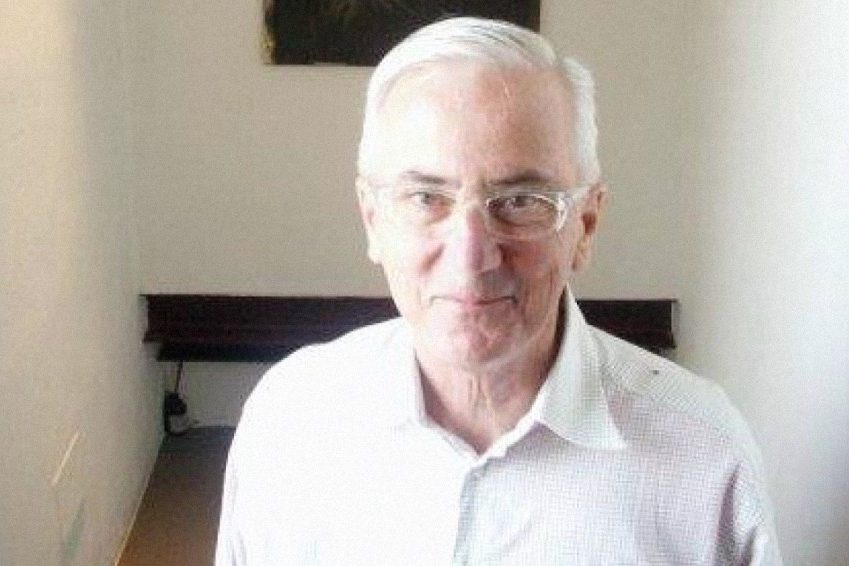Whether you are planning an overseas adventure to the old Kingdom of Trinacria, or simply love all things Sicilian, there is one person who can provide you with all the Sicilian lore you need to know: Professor Douglas Kenning.
Douglas Kenning spends half of each year in Sicily, where he runs a tourism company, and the second half in the San Francisco Bay Area, where he teaches Mediterranean History and Culture courses. He is an esteemed lecturer at the Fromm Institute for Lifelong Learning at the University of San Francisco.
BF: Professor Kenning, may we start with your giving me some brief information about your origins and Sicilian heritage?
Douglas Kenning in the street of his apartment in Siracusa
Kenning: I am half Sicilian. My mother was born to Sicilian immigrants, both from the Mount Etna area, although they met in New York City. Theirs is a classic Italian immigration story, which I sometimes tell in my classes. My mother was born in Little Italy, NYC, and her life too is a classic immigrant story, but a story of assimilation. One aspect of many immigrants’ assimilation was marrying up, so she found a “real American”, a Midwestern army officer, and after a long and gentle courtship -under the watchful eye of her mother- in wartime Washington D.C., they married. That is why my surname (cognome) is not Italian. On my mother’s side, we are Scalia, Chisari, Zammataro, Infurna.
My own desire at mid-life to move to Sicily itself is a classic 3rd generation descendent-of-immigrants story. The rule is: the 1st generation is grateful to get out of the old country; the 2nd generation has no interest in it; and the 3rd generation find within themselves, a creeping nostalgia for the homeland they never knew. That was me, though it grew more strongly in me after I had moved to Sicily.
BF: You are a lecturer, history professor, tour guide, and president of Sicily Tour…How do you combine all these wonderful activities?
Kenning: It’s hard work. Full-time lecturer, full-time company president and full-time tour guide are three full careers. Fortunately, I am full-time lecturer only the first half of the year, although all of my free time in the second half of the year is occupied in preparing the next year’s classes. And I am a full-time tour guide only during the second half of the year, though I spend all my free time during the first half of the year working on the upcoming tour season. Being company president always requires attention, although I benefit from it being a very small company and from a brilliant colleague, Lucia, in Sicily who handles almost all the administrative work.
BF: What are your favorite topics to teach?
Kenning: The three careers I was mentioning have one thing in common: they all are about the Mediterranean, focused on Sicily. A midlife crisis sent me seeking where my heart truly was, and my heart led me to the ancient Mediterranean, primarily to the ancient Greeks, but not only. I found the Greek story in Sicily more compelling than the one back in Greece. Maybe it’s the immigrant angle again—ancient Greeks in Sicily too were strangers in a strange land, until they became the natives. From the ancient Greek world, my research broadened to include ancient Egypt, Mesopotamia, Minoan Crete, Phoenicians, and ancient Rome. So, I love all my lecture topics, which I should, since I am very lucky to be able to choose what fascinates me enough to spend the hundreds of hours preparing 12-16 hours of lectures. If forced to choose, I would pick my History of Sicily and Ancient Greek courses as favorites.
BF: In March you will hold a series of lectures at the Museo Italo Americano entitled “Great Caesar’s Ghost!”. What is the focal point of these lectures, and how did you design the whole series?
Kenning: Well, the History of Sicily lectures I give at Lifelong Learning Institutes around the San Francisco Bay Area spawned a companion History of Italy lecture series. It was a natural progression. Paola Bagnatori, the Museo’s director, was gracious enough to give me a chance to offer History of Sicily last March, and requested I follow it this year with a History of Italy. Most of my history lecture series are in part chronological and in part thematic. This program, however – designed to help people grasp the sequence of periods, events, and artistic styles – is strictly chronological. Three thousand years in four 2-hour sessions. It’s sort of a high-altitude flyover of the history of Italy, enough to give folks a framework into which to slot events, people, artwork, and buildings that they know already or will encounter when they go to Italy.
BF: Could you give some recommendations to people who want to take trips to Sicily that are more insightful than the ones usually offered by standard commercial travel agencies?
Kenning: How could I answer that in any way but to say . . . us? I mean my company: Sicily Tour. Of course, our tours are more “insightful”, since I can define “insightful” here and I define it as “to see in[to]”, looking deeper. And that is what we do at Sicily Tour. We spend our time on the stories of Sicily, which means its histories and its mythic stories. On our tours, we eat wonderful food, take in emotionally moving landscapes, see amazing art, but so do people on other tours. If you come with us, you come for the stories.
Next month, keep your eyes peeled for Professor Douglas’ lectures every Thursday evening at 7pm, at your Museo Italo Americano. Be ready for full immersion in stories that will captivate your imagination!
Info: www.sfmuseo.org
Sicily Tour: http://www.sicily-tour.com/




























